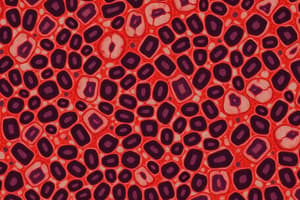Podcast
Questions and Answers
What distinguishes endocrine glands from exocrine glands?
What distinguishes endocrine glands from exocrine glands?
- Endocrine glands secrete hormones into the bloodstream. (correct)
- Endocrine glands are primarily unicellular.
- Endocrine glands secrete substances into ducts.
- Endocrine glands have branching ducts.
Which of the following correctly describes the classification of multicellular glands?
Which of the following correctly describes the classification of multicellular glands?
- Multicellular glands can be classified as either simple or compound based on duct branching. (correct)
- Multicellular glands are always simple in structure.
- Multicellular glands consist entirely of exocrine cells.
- Multicellular glands cannot have ducts.
Which method of glandular secretion involves the complete rupture of glandular cells?
Which method of glandular secretion involves the complete rupture of glandular cells?
- Apocrine secretion
- Merocrine secretion
- Holocrine secretion (correct)
- Serous secretion
What type of gland is characterized by having no ducts and secreting directly into the bloodstream?
What type of gland is characterized by having no ducts and secreting directly into the bloodstream?
Which of the following is an example of a compound gland?
Which of the following is an example of a compound gland?
Which glandular secretion method is most commonly associated with releasing watery substances?
Which glandular secretion method is most commonly associated with releasing watery substances?
What is a primary characteristic of simple glands?
What is a primary characteristic of simple glands?
Which of the following best describes keratinized stratified squamous epithelium?
Which of the following best describes keratinized stratified squamous epithelium?
What is a possible consequence of inappropriate stimulation of epithelial cells' ability to divide?
What is a possible consequence of inappropriate stimulation of epithelial cells' ability to divide?
What distinguishes the structure of acinar glands from tubule glands?
What distinguishes the structure of acinar glands from tubule glands?
What characterizes epithelial tissue in comparison to other tissue types?
What characterizes epithelial tissue in comparison to other tissue types?
Which type of epithelium is designed for absorption and secretion?
Which type of epithelium is designed for absorption and secretion?
Which classification is NOT used for epithelial tissue?
Which classification is NOT used for epithelial tissue?
Where would you typically find stratified squamous epithelium?
Where would you typically find stratified squamous epithelium?
What is the role of transitional epithelium?
What is the role of transitional epithelium?
Which cell shape is primarily involved in the exchange process in tissues?
Which cell shape is primarily involved in the exchange process in tissues?
What type of junctional complex is characteristic of epithelial cells?
What type of junctional complex is characteristic of epithelial cells?
Which type of epithelium appears to be stratified but is actually simple?
Which type of epithelium appears to be stratified but is actually simple?
In which location would you find simple cuboidal epithelium?
In which location would you find simple cuboidal epithelium?
Which type of epithelial tissue serves a barrier function and is found in the urinary system?
Which type of epithelial tissue serves a barrier function and is found in the urinary system?
Flashcards
Epithelial Tissue
Epithelial Tissue
A type of tissue that covers exterior surfaces of the body, lines internal cavities, forms glands, and contains sensory receptors.
Epithelial Tissue - Avascular
Epithelial Tissue - Avascular
Epithelial tissue lacks blood vessels.
Epithelial Cells - Surface Domains
Epithelial Cells - Surface Domains
Distinct regions of an epithelial cell with specialized functions.
Basal Lamina
Basal Lamina
Signup and view all the flashcards
Epithelial Tissue - Cell Arrangement
Epithelial Tissue - Cell Arrangement
Signup and view all the flashcards
Epithelial Tissue - Cell Shape
Epithelial Tissue - Cell Shape
Signup and view all the flashcards
Simple Squamous Epithelium
Simple Squamous Epithelium
Signup and view all the flashcards
Simple Cuboidal Epithelium
Simple Cuboidal Epithelium
Signup and view all the flashcards
Simple Columnar Epithelium
Simple Columnar Epithelium
Signup and view all the flashcards
Pseudostratified Epithelium
Pseudostratified Epithelium
Signup and view all the flashcards
Glands
Glands
Signup and view all the flashcards
Exocrine glands
Exocrine glands
Signup and view all the flashcards
Endocrine glands
Endocrine glands
Signup and view all the flashcards
Merocrine gland
Merocrine gland
Signup and view all the flashcards
Apocrine gland
Apocrine gland
Signup and view all the flashcards
Holocrine gland
Holocrine gland
Signup and view all the flashcards
Unicellular glands
Unicellular glands
Signup and view all the flashcards
Multicellular glands
Multicellular glands
Signup and view all the flashcards
Simple glands
Simple glands
Signup and view all the flashcards
Compound glands
Compound glands
Signup and view all the flashcards
Study Notes
Epithelial Tissue
- Avascular tissue that covers external body surfaces and lines internal cavities.
- Forms glands and sensory receptors.
- Composed of cells arranged in sheets.
- Cells have specialized junctions (junctional complexes).
- Distinct apical (free), lateral, and basal surface domains.
- Cells rest on a non-cellular basal lamina (protein-polysaccharide-rich layer).
Epithelial Functions
- Transport: Moves particles and mucus via cilia (e.g., trachea, bronchi).
- Sensory reception: Receives stimuli (e.g., taste buds, retina).
- Lubrication: Secretion of mucous and serous fluids.
- Excretion: Filters blood, producing urine, and sweat.
- Reproductive: Supports sperm and egg production.
Epithelial Classification
- Classified by cell arrangement (simple or stratified) and cell shape (squamous, cuboidal, columnar).
- Not classified by function!
Simple Epithelia - Cell Shapes
- Squamous: Width is greater than height.
- Simple Squamous: Single layer; lines blood vessels, Bowman's capsule, respiratory spaces.
- Function: Exchange, barrier (central nervous system), lubrication, barrier between compartments.
- Cuboidal: Width, depth, and height are approximately the same.
- Simple Cuboidal: Single layer; found in thyroid follicle walls, kidney tubules, ovary surface, and small ducts of exocrine glands.
- Columnar: Height greatly exceeds width.
- Simple Columnar: Single layer; lines the intestinal tract (stomach to rectum), uterus, and cervix, and gall bladder.
- Function: Absorption, secretion, and barrier.
- Pseudostratified: Appears stratified but all cells rest on the basal lamina; a simple epithelium..
- Found in the respiratory tract (trachea, bronchi), epididymis, and ductus deferens; frequently ciliated or with stereocilia.
- Transitional: Stratified epithelium that accommodates distension; found in the urinary bladder, part of the urethra, and ureter, and renal calyces.
- Stratified Squamous: Multiple layers; superficial layer is squamous. Functions as a barrier; protects the body.
- Keratinized: Epidermis (skin).
- Non-keratinized: Lining of oral cavity, vagina, and esophagus.
Glands
- Specialized epithelial cells for secretion.
- Exocrine: Secrete onto an epithelial surface via ducts (sweat, earwax, saliva, digestive enzymes).
- Endocrine: Secrete hormones into the bloodstream.
- Paracrine: Secrete into the extracellular space.
Exocrine Gland Classification
- Unicellular: Composed of a single cell (e.g., goblet cell).
- Multicellular: Composed of multiple cells.
- Simple: Duct does not branch.
- Compound: Duct branches.
- Shape: Acinar/alveolar (sac-like), tubule (straight, coiled, branched).
Gland Secretion Methods
- Merocrine: Most glands; watery secretions (saliva, digestive enzymes, watery sweat).
- Apocrine: Smelly sweat (e.g., sweat glands).
- Holocrine: Cells die and rupture to release products (e.g., sebaceous glands).
Epithelial Regeneration
- Continuously recycled (e.g., epidermis, intestinal epithelium).
- Abnormal cell division can lead to tumors.
- Epithelial cancers are called carcinomas.
- Glandular cancers are called adenocarcinomas.
Studying That Suits You
Use AI to generate personalized quizzes and flashcards to suit your learning preferences.




